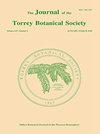马萨诸塞州霍利奥克山脉基岩和地形对土壤和植物分布的影响
IF 0.8
4区 生物学
Q4 PLANT SCIENCES
引用次数: 32
摘要
在山脉的北边有24对。对于每个样地,我们测量了坡度、样地坡向、土壤pH值和土壤养分、树木的重要性值、样地内灌木的频率,并记录了草本类群的存在/缺失。玄武岩上的土壤pH值较高,养分含量更丰富,尤其是可交换性钙和镁。利用土壤变量对样地进行主成分分析,与基岩相关的土壤差异占总方差的51%,与坡向相关的土壤差异占22%。多响应排列过程表明,各植被层在基岩和坡向上的分布存在显著差异。玄武岩上的乔木和草本植物物种丰富度均显著较高,而玄武岩南侧的草本植物物种丰富度也较高。在超过5%的样地中,有32%的样地仅在基岩类型上存在显著差异,21%的样地在基岩类型和坡向上都存在显著差异,而与基岩无关的坡向上存在显著差异的仅有9%。差异最大的是草本层。利用土壤和立地变量的典型对应分析表明,所有植被层的最强梯度与基岩有关。本文章由计算机程序翻译,如有差异,请以英文原文为准。
Influence of bedrock and aspect on soils and plant distribution in the Holyoke Range, Massachusetts
and 24 pairs on the north side of the range. For each plot we measured slope, plot aspect, soil pH and soil nutrients, the importance value for trees, within-plot frequency for shrubs and recorded presence/absence for herbaceous taxa. Soil on basalt had a higher pH and was richer in nutrients, particularly exchangeable Ca and Mg than soil on arkose. Principal Components Analysis of plots using soil variables indicated that those associated with bedrock accounted for 51% of the variance while soil differences related to aspect accounted for 22%. The multi-response permutation procedure indicated significant differences in distribution in all vegetation layers with respect to both bedrock and aspect. Species richness on basalt was significantly higher for both trees and herbaceous plants, and was also higher on the south side of the range for herbaceous plants. Of the 89 species present in more than 5% of the plots, 32% had significantly different distributions with respect to bedrock alone, 21% differed significantly with respect to both bedrock type and aspect while only 9% differed significantly with aspect independent of bedrock. The largest differences were in the herbaceous layer. Canonical correspondence analysis using soil and site variables indicated that for all vegetation layers the strongest gradient was related to bedrock.
求助全文
通过发布文献求助,成功后即可免费获取论文全文。
去求助
来源期刊
CiteScore
0.70
自引率
0.00%
发文量
16
审稿时长
>12 weeks
期刊介绍:
The Journal of the Torrey Botanical Society (until 1997 the Bulletin of the Torrey Botanical Club), the oldest botanical journal in the Americas, has as its primary goal the dissemination of scientific knowledge about plants (including thallopyhtes and fungi). It publishes basic research in all areas of plant biology, except horticulture, with an emphasis on research done in, and about plants of, the Western Hemisphere.

 求助内容:
求助内容: 应助结果提醒方式:
应助结果提醒方式:


